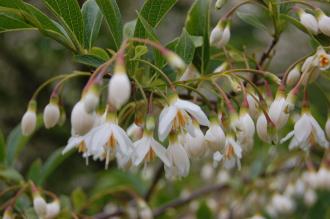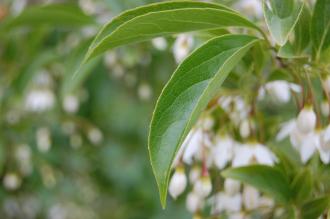
Styrax japonicus (15/05/2015, Kew Gardens, London)
Position: Full sun to partial shade
Flowering period: Late spring to early summer
Soil: Moist, well drained, neutral to acid
Eventual Height: 8m
Eventual Spread: 8m
Hardiness: 6a, 6b, 7a, 7b, 8a, 8b, 9a
Family: Styracaceae
Styrax japonicus is a deciduous tree with a vase shaped, spreading habit. Its mid green leathery leaves are ovate to elliptic with entire margins, up to 10cm long and 5cm across. Its leaves turn yellow/ orange in autumn before they fall. Its brown bark is smooth and develops orange/ brown interlacing as it matures. Its lightly fragrant pendulous white flowers are bell shaped, up to 15mm across and appear as terminal racemes. Its green fruit is a drupe.

Styrax japonicus Flower (15/05/2015, Kew Gardens, London)
Styrax japonicus, commonly known as Japanes Snowbell or Snowflake Flower, is native to Japan, east China and Korea.
The etymological root of the binomial name Styrax is derived from the ancient Greek name for the Storax Gum Tree (Styrax officinalis). Japonicus is derived from the Latin meaning ‘from Japan’.

Styrax japonicus Leaf (15/05/2015, Kew Gardens, London)
The landscape architect may find Styrax japonicus useful as a small late spring flowering tree suitable for acid soils. This tree prefers a sheltered position.
Ecologically, Styrax japonicus flowers are attractive to pollinating insects.
The Royal Horticultural Society has given a number of varieties of Styrax japonicus their prestigious Award of Garden Merit.
Styrax japonicus prefers moist, humus rich, well-drained soils. It prefers a neutral to acid pH of soil.
Styrax japonicus requires little maintenance. Lower branches ma be removed to promote the attracve vase shaped habit.

Landscape Architecture

